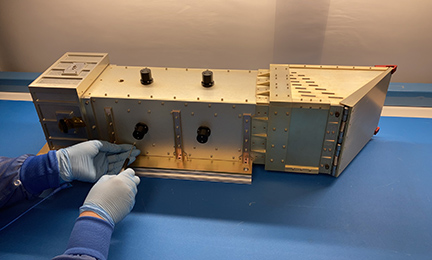Research
We work on a variety of topics related to Earth’s space environment, space weather, and space technology. With an increasing reliance on the space environment for human endeavors, an understanding of this region and the governing physics is critical. Our research spans from small satellite and UV and x-ray instrumentation development, to analysis and modeling of space plasma physics, to development of novel space technologies.
Instrumentation
New discoveries often require new sensors and observing systems. We innovate and use advancing technologies to develop sensor systems. Our group members include diverse scientists and engineers and use gaps in the community’s understanding of space to motivate our technology development. Areas of focus include UV and X-ray instrumentation, sensors, and focusing systems as well as high energy charged particle sensing. UV and X-ray systems provide exciting potential in providing global images of Earth’s space environment. Development includes lab experiments, advanced additive manufacturing, lab sensor development, and space-based experiments through sounding rockets and orbital flights. Previous missions: DXL/STORM, CuPID Cubesat. Upcoming missions: LEXI, Carruthers Geocorona Observatory.

LEXI (Lunar Environment Heliospheric X-ray Imager) undergoing final checkouts before delivery to the lunar lander for flight in 2024
Space Sciences
We seek to understanding the dynamics and evolving plasma world of our local solar system. As residents and explorers of the near-Earth space environment, we work to develop a physical understanding of the underlying physics controlling its properties and behavior. Our work utilizes measurements from in-situ as well as imaging space-based missions such as THEMIS, MMS, WIND, SMILE, NICER, and FAST. We develop and use novel analysis methods to explore multi-dimensional datasets including machine learning techniques such as gaussian processes and recurrent neural networks.
Of particular interest is how energy from the flowing solar wind interfaces with and drives Earth’s magnetosphere and ionosphere as well as that at other planets. How does physics at a planetary shock, magnetosheath, and magnetopause impact this transfer of energy, and how does the planet itself and its native plasma populations influence the transfer of energy and generation of geomagnetic storms?
- PRIME: a probabilistic neural network approach to solar wind propagation from L1, O’Brien et al., 2023
- Statistical Comparison of Dayside Magnetopause Reconnection X-Line Prediction Models, Qudsi et al., 2023
- Unsteady Magnetopause Reconnection Under Quasi-Steady Solar Wind Driving, Zou et al., 2022
- The role of magnetospheric plasma in solar wind-magnetosphere coupling: A review, Walsh et al., 2021

